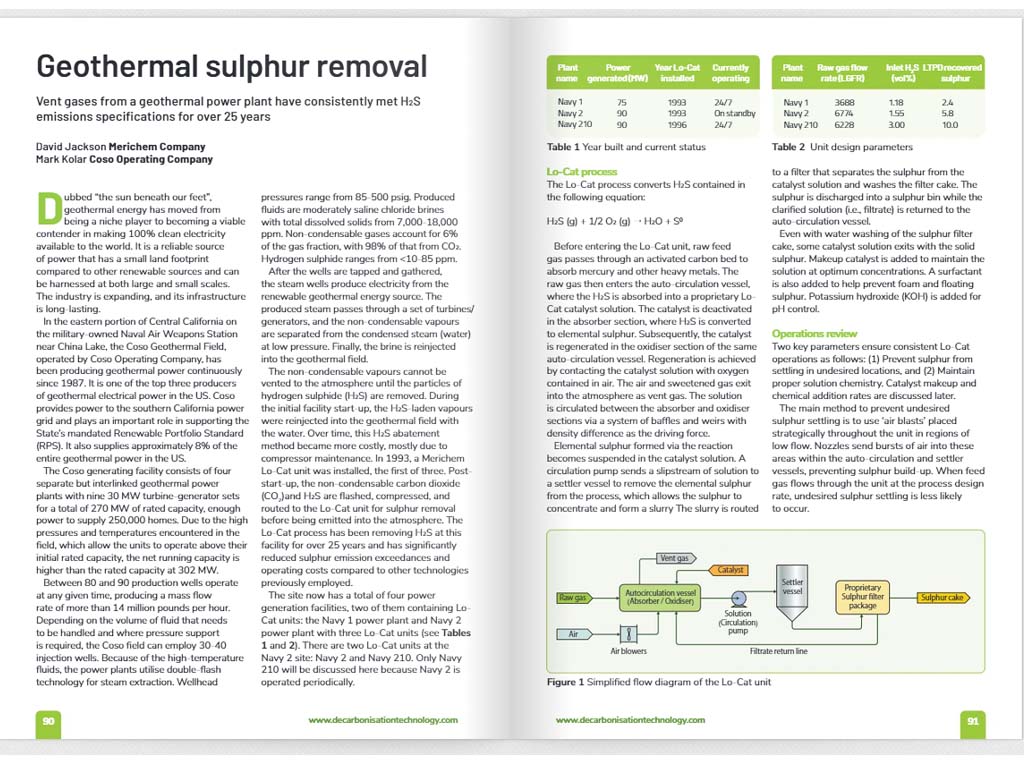Geothermal sulphur removal

Vent gases from a geothermal power plant have consistently met H2S emissions specifications for over 25 years
David Jackson Merichem Company
Mark Kolar Coso Operating Company
Dubbed the sun beneath our feet, geothermal energy has moved from being a niche player to becoming a viable contender in making 100% clean electricity available to the world. It is a reliable source of power that has a small land footprint compared to other renewable sources and can be harnessed at both large and small scales. The industry is expanding, and its infrastructure is long-lasting.
In the eastern portion of central california on the military-owned naval air weapons station near china lake, the coso geothermal field, operated by coso operating company, has been producing geothermal power continuously since 1987. It is one of the top three producers of geothermal electrical power in the us. Coso provides power to the southern california power grid and plays an important role in supporting the states mandated renewable portfolio standard (rps). It also supplies approximately 8% of the entire geothermal power in the us.
The coso generating facility consists of four separate but interlinked geothermal power plants with nine 30 mw turbine-generator sets for a total of 270 mw of rated capacity, enough power to supply 250,000 homes. Due to the high pressures and temperatures encountered in the field, which allow the units to operate above their initial rated capacity, the net running capacity is higher than the rated capacity at 302 mw.
Between 80 and 90 production wells operate at any given time, producing a mass flow rate of more than 14 million pounds per hour. Depending on the volume of fluid that needs to be handled and where pressure support is required, the coso field can employ 30-40 injection wells. Because of the high-temperature fluids, the power plants utilise double-flash technology for steam extraction. Wellhead pressures range from 85-500 psig. Produced fluids are moderately saline chloride brines with total dissolved solids from 7,000-18,000 ppm. Non-condensable gases account for 6% of the gas fraction, with 98% of that from co2. Hydrogen sulphide ranges from <10-85 ppm.
After the wells are tapped and gathered, the steam wells produce electricity from the renewable geothermal energy source. The produced steam passes through a set of turbines/ generators, and the non-condensable vapours are separated from the condensed steam (water) at low pressure. Finally, the brine is reinjected into the geothermal field.
The non-condensable vapours cannot be vented to the atmosphere until the particles of hydrogen sulphide (h2s) are removed. During the initial facility start-up, the h2s-laden vapours were reinjected into the geothermal field with the water. Over time, this h2s abatement method became more costly, mostly due to compressor maintenance. In 1993, a merichem lo-cat unit was installed, the first of three. Post start-up, the non-condensable carbon dioxide (co2) and h2s are flashed, compressed, and routed to the lo-cat unit for sulphur removal before being emitted into the atmosphere. The lo-cat process has been removing h2s at this facility for over 25 years and has significantly reduced sulphur emission exceedances and operating costs compared to other technologies previously employed.
Full Article Decarbonisation Technology
